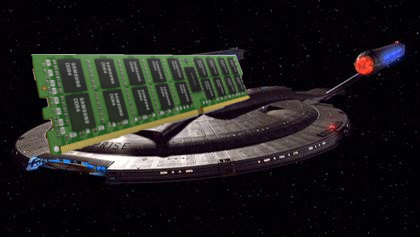Raw memory. These are the voyages of the OS hacker. Deep into the bytes, driven by the knowledge they may bring. To boldly go where no typecast has gone before.
Today, we explore in the bits forgotten, and the bits yet to be seen! Memory manipulation can be difficult, and to understand real memory allocators, you need to be comfortable thinking in terms of pointers, arrays, references, and typecasts. A few things to remember:
- When you dereference a pointer of type
type *p, you're accessing the nextNbytes whereN = sizeof(type). - When you add to a pointer
p, the new pointer is at the numerical addressp + sizeof(*p). - Doing pointer math such as
p + 4is the same as&p[4]-- and most people find the array syntax to be more clear than pointer math.
Now that you're equipped to plunge into the depths of the virtual address space, dodging stray NULLs, while seeking out the wisdom of the storied 0xdeadbeef alien race.
They are known to have in their possession the meaning of life, the universe, and everything, and we must know!
Our primary equipment is quite capable. View its glory:
$ make
$ ./bin README.md
But first, we must voyage to the planet of the elfs. Starting survey!
$ ./bin bin
bin is now operating on itself!
But what is it doing?
Now we dive deep into the exotic, yet exceedingly common Elf format. It is the format for each of our programs and is a well-defined standard.
Behold in glory: the Elf starsystem!
The Elf file format has a header at the start of the file that has a well-formed and defined structure.
We have encoded this strange beast in elf_dump.c.
Scattered throughout the elf format are a number of offsets.
These specify an offset into the binary file (i.e. from the start of the file).
Observe how we have already used the elf header to find the Program Headers.
./bin bin
See what those look like with the professional scanning tools:
$ objdump -x bin | head -n 27
We can see the address at which the binary is supposed to start execution (start address), and the program headers.
These are the ranges of memory that are loaded by the OS into memory to execute the program.
Notice again the off "offsets" that represent the offset into the file/memory at which that section's memory exists!
- Q1: What is the "Entry address" parsed out by
./bin bin? What code (seeobjdump -S bin) does this correspond to? - Q2: In what ways is there symmetry in the output between the
objdumpoutput and that of./bin bin?
We have every indication that the key to everything is awaiting discovery within a LOADABLE section -- which means that the section should get loaded into memory when we execute the program -- that includes both readable and writeable data (see objdump output)!
- Q3: What does this section hold? Make an educated guess.
In elf_dump, we have found the appropriate section, and where it is in the binary.
What we must now do, is find where 0xDEADBEEF exists in memory in the loadable, read/write section.
Note that 0xDEADBEEF is 4 bytes large (e.g. uint32_t).
Once we find it, we must find the second instance of 0xDEADBEEF.
Between the two flanking 0xDEADBEEFs is the key to everything.
0xDEADBEEF the secrets that you must retrieve lie here in memory 0xDEADBEEF
Go forth and find the key to everything, and report back for the greater good of humanity!
- Q4: What is the answer to life, the universe, and everything?

